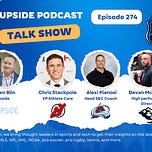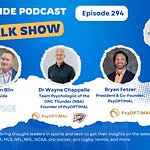This week we have the honor to interview a group of NHL sports performance executives to talk about the latest trends in the world of sports performance in the NHL.
Alexi Pianosi, Head S&C coach, Colorado avalanche (NHL Team).
Devan McConnell, High performance director, Utah Mammoth (NHL Team).
Chris Stackpole, VP Athlete Care, NJ Devils (NHL Team).
You can watch the video interview below by clicking on the Youtube link. You can also listen to the audio interview by clicking on the link at the top of the page:
📝Show Notes: Through this interview, we touched on the best practices related to:
Data & Metrics
ROI of Technology
Emerging Tech
Balancing Data with Human Observations
Team Culture & Leadership
You can read the full transcript of the podcast interview located at the top of this blog post.
Here are some of the best quotes of our conversation with Alexi, Chris and Devan:
Q1. Data & Metrics
Devan McConnell:
“Our sports science platform is built around collecting as much relevant information as possible, but the trick is knowing which data actually matters for decision-making. On the ice, we use wearable technology to help us understand workload and intensity—things like skating volume, speed profiles, and heart rate data. In the weight room, we lean heavily on force plates and velocity-based training to track neuromuscular readiness and performance over time. More recently, we’ve incorporated technologies like the 1080 Sprint and 1080 Cables to create individualized force profiles on players. That kind of insight allows us to tailor training programs more precisely, rather than assuming a one-size-fits-all approach. It goes beyond traditional performance metrics and gives us a competitive edge in customizing how we load, recover, and develop each athlete throughout the season.”
Chris Stackpole:
“For us, the critical data isn’t just about performance output—it’s also about making sure players maintain their physical capabilities across a long, grueling season. So, we track things like muscle mass, fat mass, and even treatment frequency. Range of motion data is huge too, because when athletes start losing mobility, their risk of injury skyrockets. So it’s not always about hitting top speed or max wattage—sometimes it’s about maintaining the basics so they don’t break down. If we can catch those subtle changes early and intervene, we’re not just improving performance, we’re reducing time lost to injury.”
Alexi Pianosi:
“The challenge in hockey is that the data doesn’t always capture what’s really happening on the ice. In field sports, GPS metrics like acceleration thresholds or max velocity are easy to interpret—you sprint, you stop, you change direction. But in hockey, you’ve got gliding, edge work, contact, puck battles—none of which show up in clean data points. That creates a disconnect between testing numbers and actual game performance. So the real work for us is bridging that gap—figuring out how to connect the dots between lab-based data and the chaotic, unpredictable demands of hockey. That’s where the real edge lies.”
Q2. ROI of Technology
Devan McConnell:
“Return on investment is one of the trickiest things about sports tech. The reality is, the true payoff often comes down the road—better injury resilience two years from now, or improved development curves for young players that you won’t see until they hit their prime. But we don’t always have the luxury of waiting years to find out if something works. So we have to make decisions quickly and be pragmatic. For me, ease of use is absolutely critical. Our environment is chaotic—multiple games a week, travel, short practices—and if a piece of technology makes the workflow harder, it better be solving a problem we can’t solve any other way. Otherwise it’s just noise. If the staff can’t use it seamlessly and consistently, it’s not worth the investment.”
Chris Stackpole:
“Technology is only as good as the people using it. If the practitioners don’t really understand what it does or how to implement it properly, then you’re going to end up giving players and coaches misleading feedback. That’s dangerous, because once trust is broken, it’s hard to get it back. For me, ROI isn’t just about the money spent—it’s about accuracy, practicality, and making sure the information you provide actually improves decision-making. If it doesn’t check those boxes, then it’s not a good investment, no matter how shiny or popular the technology might be.”
Q3. Emerging Tech
Devan McConnell:
“If you look at where we are as a field, we’re pretty good at making athletes stronger, faster, and more powerful. The next big frontier, in my opinion, is recovery. For us in the Western Conference, travel is brutal—you’re dealing with time zone changes, late nights, early mornings, and long flights. The question we’re constantly asking is: how do we help players recover faster and get back to baseline more quickly? That’s where I see the next wave of innovation coming—tools and strategies that truly optimize recovery, not just for the next practice, but for long-term health and longevity.”
Alexi Pianosi:
“One of the challenges with emerging tech is that there’s always a latency period. A new device or idea comes out, but it’s not always clear how it applies to hockey right away. Hockey is such a unique sport biomechanically—things built for field sports often don’t transfer seamlessly. That’s why I think the real breakthrough won’t necessarily be some new gadget, but rather integration. Getting all the existing systems—wearables, AMS, force plates, GPS—to talk to each other and actually give us a clear, unified picture. That’s the impact tech that will really move the needle.”
Chris Stackpole:
“I think the next big leap will come in skill acquisition and decision-making. We’ve gotten so good at developing the physical qualities—strength, speed, conditioning—but hockey is ultimately about applying skills in the game. The question is: how do you maximize limited practice exposures and make players better at reading situations, making faster decisions, and executing skills under fatigue? That’s where I think tech can help us—bridging that gap between training and actual on-ice performance.”
Q4. Balancing Data with Human Observations
Chris Stackpole:
“For us, data is there to either confirm or defend. If a coach comes to me and says, ‘This player looks slow,’ we can look at the numbers and either validate that or show otherwise. It gives us an objective layer to either back up the observation or challenge it. But the point isn’t to replace the coach’s eye or the athlete’s feedback—it’s to give everyone more confidence that the decisions we’re making are grounded in reality, not just opinion.”
Alexi Pianosi:
“You always have to weigh where the subjective information is coming from. Some coaches or players you trust more than others, because their feedback tends to align with the data over time. If a veteran tells me, ‘I don’t feel right today,’ I’m probably going to trust that a lot, because usually the numbers will confirm it. But at the same time, there are players who might always say they’re tired, and you have to put that in context. So it’s always a blend—using the data to support the human side, not override it, but also not being blinded by one player’s feelings.”
Devan McConnell:
“Good sports science is both art and science. Data is incredibly valuable, but it doesn’t make decisions for us—we still have to apply context, experience, and judgment. The skill lies in knowing when to lean more on the objective side and when to trust the subjective. That’s where the best practitioners separate themselves—not in collecting the most numbers, but in knowing how to interpret them alongside what they see and hear every day.”
Q5. Team Culture & Leadership
Chris Stackpole:
“Culture, to me, is probably the single most important thing. You can have all the talent in the world, but if you don’t have shared values, accountability, and a common vision, it won’t matter. Every year we spend time not just talking about performance and rehab, but also about what kind of culture we want to build and protect. It’s not a buzzword—it’s a real driver of performance, not just for players but for staff across the entire organization.”
Alexi Pianosi:
“Culture is everything. It’s not built by one star player or one coach—it’s built by the whole organization. And it’s not just in the locker room; it shows up in the weight room, in the medical room, in how you handle adversity when things don’t go well. With a strong culture, players are more open-minded, more adaptable, and more willing to embrace new technologies and methods because they trust that everyone’s aligned. Without culture, you end up with silos, and that’s when things break down.”
Devan McConnell:
“Culture is the foundation. You can have all the motivational slogans you want, but if the organization doesn’t live up to them day in and day out, they’re meaningless. The truth is, whatever the lowest common denominator is—that’s your real culture. If even one part of the group isn’t aligned, that sets the tone. When everyone’s accountable and pulling in the same direction, that’s when you see special things happen. That’s when all the science and technology we talk about actually makes a difference, because it’s built on a foundation of trust and shared commitment.”
You may also like:
🔥Upside NHL Group Chat with Alexi Pianosi (Colorado Avalanche), Chris Stackpole (NJ Devils), Adam Douglas (Penguins)
This week we have the honor to interview a group of NHL sports performance executives to talk about the latest trends in the world of sports performance, load management, sleep/recovery management, rehabilitation and data & wearable tech integration, and mental performance in the NHL.












